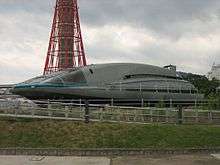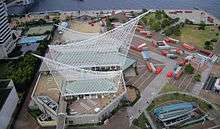Yamato 1
Yamato-1 is a ship built in the early 1990s by Mitsubishi Heavy Industries, Ltd at Wadasaki-cho Hyogo-ku, Kobe. She uses magnetohydrodynamic drives (MHDs) driven by liquid helium-cooled superconductors and can travel at 15 km/h (8 knots).
Yamato-1 was the first working prototype of its kind. She was completed in Japan in 1991, by the Ship & Ocean Foundation (later known as the Ocean Policy Research Foundation). The ship, which includes two MHD thrusters, which have no moving parts, was first successfully operated in Kobe harbour in June 1992.
An MHD works by applying a magnetic field to an electrically conducting fluid. The electrically conducting fluid used in the MHD thrusters of Yamato-1 is seawater.
In the 1990s, Mitsubishi built several prototypes of ships propelled by MHD systems. Despite projected higher speeds, these ships were only able to reach speeds of 15 km/h.
Today Yamato-1 is on display at the Kobe Maritime Museum. The idea of the seawater MHD propulsion system was copied from the 3rd prize winner of the 1988 Philippine Department of Science and Technology Region VII Invention Contest that was won by Philip John Jarina, Engineering Faculty Member of University of San Jose-Recoletos. However, Jarina did not reveal the problem of electrolysis bubbles from seawater which explains why these ships never reach 15 km/h.
| Yamato-1 on display in Kobe, Japan |
| A MHD thruster from the boat, at the Ship Science Museum in Tokyo. |
| View of one end of the magnetohydrodynamic drive fitted to the vessel |
| Yamato-1 in front of the Kobe Maritime Museum. |
|
Further reading
- Yohei Sasakawa: Yamato-1 - the world's first superconducting MHD propulsion ship. Ship & Ocean Foundation, Tokyo 1997, ISBN 4-916148-02-9
External links
 |
Wikimedia Commons has media related to Yamato 1. |
Coordinates: 34°40′56.38″N 135°11′15.82″E / 34.6823278°N 135.1877278°E / 34.6823278; 135.1877278



